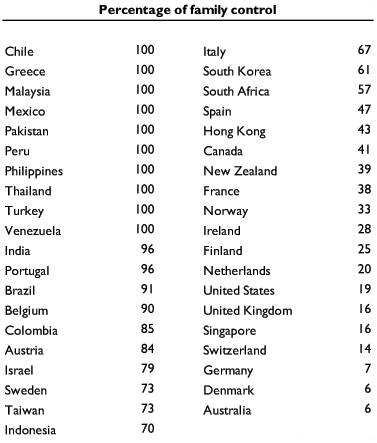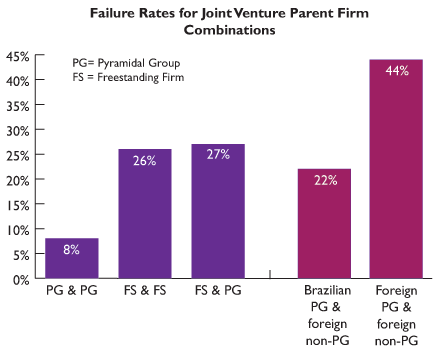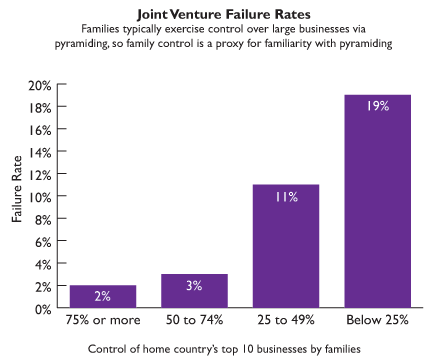Executives at Citigroup became aware of serious problems with their joint venture partnership in the Brazilian telecommunications industry in 2005. Daniel Dantas, the general manager hired by Citigroup to manage its investment in Brasil Telecom, was using his control of the partnership for blatant self-dealing. Dantas allegedly expropriated more than $300 million of the joint venture’s wealth for personal benefit and siphoned large sums to other firms in his family-controlled business group, Grupo Opportunity. Citigroup had to quickly figure out how to remove Dantas from control of Brasil Telecom or extricate itself from the partnership without losing even more value. But Citigroup would soon discover that neither option would be easily achieved. Through a pyramidal ownership structure in Brasil Telecom and a host of other related firms, Dantas had woven a complex web of concentrated control.
Foreign companies often enter joint venture partnerships unaware of the dominating corporate governance practices in developing countries, according to Susan Perkins (Assistant Professor of Management and Organizations at the Kellogg School of Management). In a recent working paper, Perkins and coauthors Randall Morck (Professor of Finance at the University of Alberta) and Bernard Yeung (Professor and Dean of the National University of Singapore) outline the potential costs of not recognizing and accounting for these dynamics in the design of a joint venture.
Understanding Pyramids
In the United States and the United Kingdom, widely held, stand-alone firms are the most common type of corporate structure. Ownership of widely held firms is spread among so many shareholders that no single party has effective control. However, in many developing countries, particularly in Latin America, business groups controlled by wealthy families are the norm (Table 1). The groups often have intercorporate holdings, often arranged in a pyramidal structure, that maximize the overall wealth of the group, sometimes at the expense of individual firms. Foreign joint venture partners who assume that their domestic partner firms always act to maximize shareholder value can be in for a rude awakening, as Citigroup discovered. Using a wealth of data obtained on Brazilian telecom joint ventures, as well as interviews with senior executives at key multinational subsidiaries in Brazil, Perkins found that these “pyramidal blind spots” have led to elevated failure rates for joint ventures between pyramidal group firms and partners from countries with little experience with this type of group.
Table 1: Family Control Indices
Family control indices are based on the largest ten private sector business entities (freestanding firms or business groups). The data are fractions of domestic entities (labor weighted) controlled by families in 1996.

Source: Kathy Fogel (2006). “Oligarchic Family Control, Social Economic Outcomes, and the Quality of Government,” Journal of International Business Studies, 37(5): 578-625.
“Setting the terms of the deal is even more important in developing countries than in the U.S. or UK,” says Perkins. In the United States, trust in corporate agents and professional managers comes from strong market institutions with credible enforcement mechanisms. Efficient markets are fueled by the free flow of information, transparency, and the knowledge that the legal system is equipped to penalize outliers.
In Brazil, trust is more relationally based, established outside of markets and the legal system. Those in control of pyramidal firms are therefore more likely to establish provisions within the joint venture agreement that ensure punitive damages if trust is breeched.
Foreign joint ventures have definite benefits and, in some cases, are required to enter local markets. Many foreign companies use joint venture partnerships to mitigate the “ldquo;liability of foreignness”—their unfamiliarity with local rules, culture, and business practices. However, if a company enters into a partnership unaware of the opaque local ownership and control schemes that potentially work against its interests, it could be setting itself up for disappointment and failure.
Pyramidal business groups are set up in a tiered structure, with firms at the apex holding partial control of lower firms, which in turn hold partial control of still lower firms, and so on. Pyramidal groups leverage the owner’s wealth into a vast amount of controlled corporate assets with only limited participation in any one unit, especially at the lower tiers. The family at the top places much more emphasis on control than on direct ownership, accomplishing this by holding super-voting shares, charters limiting shareholder voting rights, and charters that allow them to appoint directors and managers.
According to Perkins, the biggest risk for a foreign firm unaware of these dynamics when entering a joint venture involves asset and profit shifting.
“A partner firm may be at the bottom of a pyramid, six levels below the apex, but the controlling owner at the top has access to cash flow and corporate assets all the way down in a structure that is rarely transparent,” explains Perkins. “This can result in ‘tunneling,’ shifting money to different parts of the structure, or simple expropriation, buying jets, paying for country club memberships, unrelated legal fees, etc.”
Survival and Failure
Perkins and her colleagues examined the entries of ninety-six multinational subsidiaries into the Brazilian telecommunications industry between 1997 and 2004. They assessed the performance of partnerships of different parent firm combinations, with each parent classified as freestanding or a member of a pyramidal group. These were further divided into Brazilian and non-Brazilian firms.
The results showed that partnerships between freestanding firms and firms that are part of pyramidal structures are much more likely to fail (a 27 percent failure rate), and partnerships between firms that are both part of pyramidal structures have the highest rates of survival (only an 8 percent failure rate) (Figure 1). Perkins explained this dual-pyramidal advantage by suggesting that both parties better understand their partner’s governance and agency motivations, and also employ countermeasures to neutralize opportunism.
Figure 1: Failure rates for joint venture parent firm combinations
Having a Brazilian partner also made a difference. Non-pyramidal firms had significantly lower failure rates (22 percent) when they partnered with Brazilian pyramidal firms than when they partnered with foreign pyramidal firms (44 percent).
Further, the researchers assessed how firms’ familiarity with pyramidal business groups impacted performance. Using an index that measures the degree of family control in the top ten business entities in several countries, the team found that firms with the lowest failure rate (2 percent) were from countries where at least 75 percent of firms were part of pyramidal groups. The highest failure rate (19 percent) was among firms from countries where less than 25 percent of firms are part of pyramidal groups (Figure 2).
Figure 2: Joint Venture Failure Rates
Source: Kathy Fogel (2006). “Oligarchic Family Control, Social Economic Outcomes, and the Quality of Government,” Journal of International Business Studies, 37(5): 578-625.
“If a company wanted to predict its chances for success in a given venture, those findings are really a barometer for who should be most concerned. If your firm is from a country with little understanding of how pyramidal group structures operate, you have a much greater chance of being caught in a pyramidal trap,” says Perkins.
But what about the high survival rate for partnerships when both firms are from pyramidal groups? In such ventures, managers from both parent firms often have a better understanding of the risks and challenges. They build safeguards to prevent one firm from undermining the other.
“One way of doing this is to arrange multiple points of competition and interaction,” says Perkins. “This gives both parent firms incentives to be trustworthy partners by giving each partner multiple means to retaliate if the other acts opportunistically.”
Perkins found three key features of successful partnerships between multiple pyramid firms:
1) Cash flow and voting rights are more commonly split evenly.
2) Decision-making control is assigned to top managers of each parent firm, property by property, not allocated overall to one parent or the other.
3) Each firm takes some ownership of high-level firms in the other’s pyramidal group.
This strategy gives ammunition to each firm to strike back if the other acts unscrupulously. In the case of Citigroup, it relinquished too much control to Dantas, assuming he would act in the interest of the partnership. When it became obvious that Dantas was behaving in his own self-interest, Citigroup had little means to rein him in and control its losses.
Lessons Learned
Perkins observes that although many U.S. corporations doing business in Brazil have begun to set up deals differently, those that have not often end up in unresolved legal battles.
“Senior executives still have difficulties identifying the blind spots,” she says. “I frequently hear executives say, ‘We are still waiting for our case to be adjudicated.’ They don’t realize that in many cases these practices are actually legally enshrined in corporate governance codes that specify that directors act in the interest of their business group.”
Market regulators in Brazil recognize that these governance issues are problematic for outside investors and have reformed the “rules of the game” from within. In 2000 the Brazilian stock exchange Bovespa almost imploded when the market became illiquid. In 2001 major reforms were established, with stronger minority shareholder rights and an effort to establish “one vote, one share” rules. The results so far are mixed, but Perkins believes that much of the current market liquidity in Brazil is coming from firms with strong, transparent governance structures. She plans to study those phenomena in subsequent research efforts.
“We want to examine if these reforms really have broken the status quo, or if the large firms are just figuring out how to redress themselves. Some Brazilian executives see this as a problem affecting the flow of investment and one that stymies growth, and others do not want the system exposed,” Perkins says. “The strength of reforms in the Novo Mercado, or the New Market, is indicative of how viable Brazil is in the transition from an emerging to a developed market.”
In another sign of change, Daniel Dantas, the financier who bilked Citigroup for $300 million, was convicted of bribery in December 2008 and may face ten years in prison. Perkins calls the conviction a signal to the world that this type of behavior will not be tolerated and a sign that the country is moving forward.
Perkins, Susan, Randall Morck, and Bernard Yeung (2008). “Innocents Abroad: The Hazards of International Joint Ventures with Pyramidal Group Firms,” working paper, available at SSRN: http://ssrn.com/abstract=1097265.